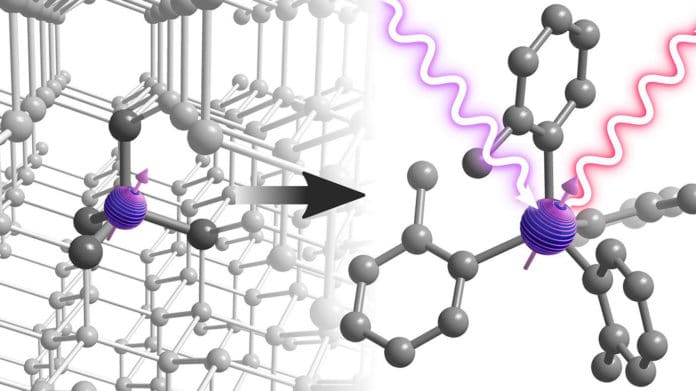In quantum computing, a qubit or quantum bit is the basic unit of quantum information, analogous to a bit in ordinary machines.
An interdisciplinary team of physicists and chemists at the University of Chicago and Northwestern University have developed a new method for creating tailor-made qubits. The method chemically synthesizes molecules that encode quantum information into their magnetic, or “spin,” states.
This new bottom-up approach could eventually prompt quantum systems with extraordinary adaptability and control, helping pave the way towards next-generation quantum technology.
David Awschalom, the Liew Family Professor in Molecular Engineering at the Pritzker School of Molecular Engineering (PME), said, “This is a proof-of-concept of powerful and scalable quantum technology. We can harness the techniques of molecular design to create new atomic-scale systems for quantum information science. Bringing these two communities together will broaden interest and has the potential to enhance quantum sensing and computation.”
Scientists used organometallic chromium molecules to create a spin state that they could control with light and microwaves.
By exciting the molecules with controlled laser pulses and measuring the light emitted, they could “read” the molecules’ spin state after being set in a superposition—a critical necessity for using them in quantum technologies.
By varying just a few different atoms on these molecules through synthetic chemistry, they could also modify both their optical and magnetic properties, highlighting the promise for tailor-made molecular qubits.
Awschalom said, “Over the last few decades, optically addressable spins in semiconductors are extremely powerful for applications including quantum-enhanced sensing. Translating the physics of these systems into a molecular architecture opens a powerful toolbox of synthetic chemistry to enable novel functionality that we are only just beginning to explore.”
Danna Freedman, professor of chemistry at Northwestern University, said, “Our results open up a new area of synthetic chemistry. We demonstrated that synthetic control of symmetry and bonding creates qubits that can be addressed in the same way as defects in semiconductors. Our bottom-up approach enables both functionalizations of individual units as ‘designer qubits’ for target applications and the creation of arrays of readily controllable quantum states, offering the possibility of scalable quantum systems.”
“One potential application for these molecules could be quantum sensors that are designed to target specific molecules. Such sensors could find specific cells within the body, detect when food spoils, or even spot dangerous chemicals. This bottom-up approach could also help integrate quantum technologies with existing classical technologies.”
Sam Bayliss, a postdoctoral scholar in the Awschalom Group at the University of Chicago’s Pritzker School of Molecular Engineering and co-first author on the paper, said, “Some of the challenges facing quantum technologies might be able to be overcome with this very different bottom-up approach. Using molecular systems in light-emitting diodes was a transformative shift; perhaps something similar could happen with molecular qubits.”
Daniel Laorenza, a graduate student at Northwestern University and co-first author, sees tremendous chemical innovation potential in this space. “This chemically specific control over the environment around the qubit provides a valuable feature to integrate optically addressable molecular qubits into a wide range of environments.”
Journal Reference:
- S. L. Bayliss et al. Optically addressable molecular spins for quantum information processing, Science (2020). DOI: 10.1126/science.abb9352
